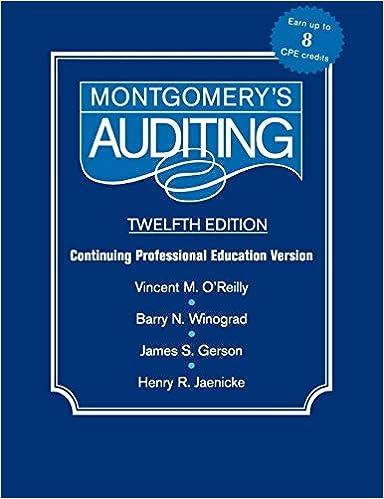Question
Taylor Co. and John Co. have the following ratios: Taylor Co. John Co. Debt to equity ratio 60% 80% Return on assets 10% 12% Return
Taylor Co. and John Co. have the following ratios:
|
| Taylor Co. | John Co. |
| Debt to equity ratio | 60% | 80% |
| Return on assets | 10% | 12% |
| Return on equity | 6% | 9% |
| Current ratio | 3.0 | 2.0 |
What do the ratios tell us about the companies?
| a. | Taylor has lower risk and lower profitability | |
| b. | Taylor has lower risk and higher profitability | |
| c. | Taylor has higher risk and lower profitability | |
| d. | Taylor has higher risk and higher profitability | |
| e. | There is no clear answers based on the ratios given |
At the end of the year, a company has two types of inventory with the following information:
| Type | Units | Cost per Unit | Market per Unit |
| A | 20 | $6 | $4 |
| B | 30 | $7 | $8 |
The year-end adjustment, if any, would include a:
| a. | Credit to Inventory for $10 | |
| b. | Credit to Cost of Goods Sold for $40 | |
| c. | Debit to Cost of Goods Sold for $10 | |
| d. | Credit to Inventory for $40 | |
| e. | No adjustment is necessary |
Which of the following is allowed under international accounting rules but not allowed under U.S. accounting rules?
| a. | Capitalization of product development cost | |
| b. | Reversal of previous inventory write down | |
| c. | Recording an increase in the fair value of property and equipment | |
| d. | Reporting cash flows from interest paid as a financing activity | |
| e. | All of the above are allowed under international accounting rules and not allowed under U.S. accounting rules |
If you could please post your work/reasoning, that'd be great! thanks!
Step by Step Solution
There are 3 Steps involved in it
Step: 1

Get Instant Access to Expert-Tailored Solutions
See step-by-step solutions with expert insights and AI powered tools for academic success
Step: 2

Step: 3

Ace Your Homework with AI
Get the answers you need in no time with our AI-driven, step-by-step assistance
Get Started


